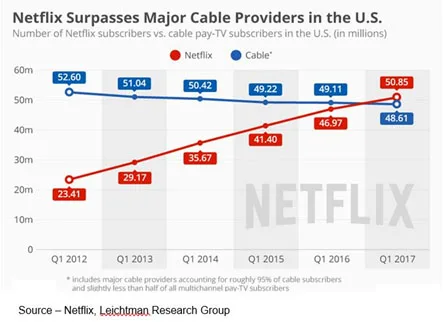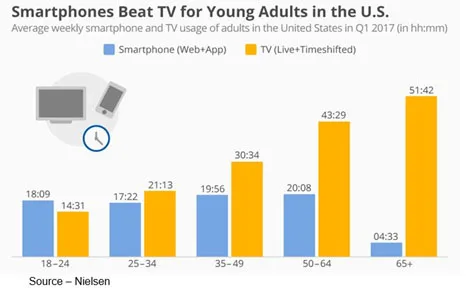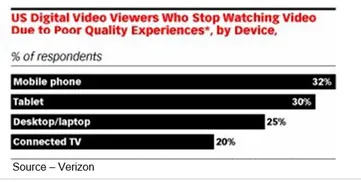Service Providers Wait Impatiently to be Back on Top

When we first heard that T-Mobile had just signed a deal with Netflix to give them the service free we thought:
- That’s a desperation move on Legere’s part because the SVOD (subscription video-on-demand service) was really going to hit their profits
- Darn, he must have gotten one helluva’ deal to offer the service
- OMG, he’s going to pull in any millennial and pre-millennial who hears about the deal
- Can’t be unlimited service because that will choke their network
But that was a shrewd move for the underdog mobile phone company.
So shrewd that AT&T added HBO Go and MetroPCS added Amazon Prime.
Not to be outdone Verizon added Yahoo!

Even with the eventual departure of Disney and Fox from their line-up, they have a lot of binge-worthy shows. And with over 2B subscribers worldwide, they have a channel that sane management wants to be on–even if they don’t particularly like Netflix.
Traditional TV people like to point out they’re “maintaining” their market share, while OTT people say most people prefer watching content on the big screen.
They’re both kinda’ right:
- Traditional is strongest with the older (boomer, post-boomer) viewing crowd
- OTT is growing like crazy, especially with millennials who like the new viewing freedom

The nice thing is as you look around, you’ll find research that supports any position you want to take.
Nielsen reported that approximately 50 percent of North American households watched traditional (regularly scheduled) TV. However, 79 percent of those individuals were late millennials, boomers, post boomers.
MediaCom reported that on-demand and mobile services are rapidly changing the viewing patterns of everyday consumers. While 84 percent of early/mid millennials and young people watch live programming, they tend to use streaming services–even as they watch them on home TV sets.
Kids, teens and early millennials prefer an even greater choice of when, where and how to watch their videos, shows and movies.
Netflix is the most widely used streaming service, with 58 percent of 13-to 19-year-olds using the on-demand service and smartphone viewing.
For the younger set, it’s all about the screen in the hand.

Researchers agree with Zenith’s Online Video Forecast that 2017 will be the peak year of fixed-device viewing.
The younger generations (19-year-olds and younger) were almost born with smartphones in their hands and they are comfortable watching personal entertainment on their own device.
Nielsen noted that during the second quarter of the year, there was a drop off of 10 hours for 18-to 24-year-olds, compared to the prior year.
No one should be optimistic that they will return as they get older.
In addition, in developing countries, people can’t afford multiple devices so the smartphone becomes their everything device.
None of this is new to the mobile service providers; but T-Mobile was the first to step up and offer Netflix a deal they couldn’t refuse.
It makes sense because despite all the posturing, a mobile service is just a mobile service. Everyone has their favorite, even if it’s only because it’s a pain to change.
However, add content to the equation – especially free content — and suddenly, customer churn (subscriber turnover) becomes more difficult.
It was a smart move for T-Mobile because Netflix global monthly active mobile users grew 60 percent this year, compared to the previous year; and that’s not shabby.
It gives customers an added incentive to switch plus a new subsidized phone.
AT&T thought it was a helluva’ idea and quickly offered HBO NOW to new mobile subscribers.
Nice. Well, just nice.
But with Netflix investing $6B for new content vs. HBO’s lowly $2B, kids will consider the guy with the deep production pocket.
Reading between the lines on Verizon’s response, “We’ve been looking at a special offering for a long time and it’s going to be beautiful. Just can’t figure out where to hide the added fees. Our service is superior so why give stuff to the customer?”
Mobile service providers around the globe have made tremendous strides in enhancing their network performance in their 4G/LTE (long-term evolution) networks.
What’s so good about 5G?
- Download speeds 10X 45
- Could be as good as 100x
- HD movie could download in a few seconds, compared to 6 min for 4G
- Enables close to zero latency between streaming source and the viewer
It will be freakin’ awesome!
But that’s then, this is now.

That’s why folks like Netflix, Amazon and Hulu use CDNs (content delivery networks) and advanced, bandwidth-conservative codecs (software to compress/decompress data for faster transmission) to improve customer viewing satisfaction.
But according to the latest Speedtest report, U.S. carriers have made strides forward.
T-Mobile was the fastest with a speedscore of 23.17Mbs download, while Sprint was the slowest with 15.39Mbps.
 Of course, your performance may vary.
Of course, your performance may vary.
U.S. carriers have improved; but unfortunately, the U.S. ranks 46th, just ahead of Albania and behind Oman!
The average download speed in the US is 23.05 Mbps, less than half the average download speeds in Norway, the Netherlands and Hungary.
The average upload speed in the US is 8.26 Mbps.
Mobile download speed increased by almost 20 percent over last year’s report but the US’s world ranking still fell from 44th to 46th.
The biggest stumbling block for AT&T, Verizon and others is the pesky net neutrality rule which bars them from slowing or blocking their rivals’ content.
Yes, they’re lobbying and suing.
So how much of a premium do Americans pay for their leading-edge service?
According to the World Bank’s 2016 report, the monthly cost of owning/using a phone in the US is $35.62.
Only the Netherlands ($41.47), Ireland ($40.33), France ($40.27, Spain ($37.80) and Switzerland ($36.02) pay more than folks in the US — all of which have significantly faster service!
Seriously, even though US subscribers aren’t getting what they’re paying for, net neutrality (treating all content equal) is really a waste.
Verizon (and certainly the others) are looking toward the 5G future with its “dramatic improvements in speed, quality and reliability during media consumption”
They should.
In today’s Internet environment, it’s easier and less costly to distribute content for their “unfair” share of margins, profits.
With 5G, providers will rule over the vital infrastructure to put them back in the position they understand – making providers and consumers pay!
 As Louise said, “Well, we’re not in the middle of nowhere, but we can see it from here.”
As Louise said, “Well, we’re not in the middle of nowhere, but we can see it from here.”
# # #